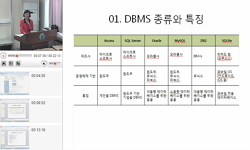- 자료제공 :

- 1 Introduction
1.1 Information Modeling
1.2 Modeling Approaches
1.3 Some Historical Background
1.4 The Relevant Skills
1.5 Summary
2 Information Levels and Frameworks
2.1 Four Information Levels
2.2 The Conceptual Level
2.3 Database Design Example
2.4 Development Frameworks
2.5 Summary
3 Conceptual Modeling: First Steps
3.1 Conceptual Modeling Language Criteria
3.2 Conceptual Schema Design Procedure
3.3 CSDP Step 1: From Examples to Elementary Facts
3.4 CSDP Step 2: Draw Fact Types, and Populate
3.5 CSDP Step 3: Trim Schema; Note Basic Derivations
3.6 Summary
4 Uniqueness Constraints
4.1 CSDP Step 4: Uniqueness Constraints; Arity Check
4.2 Uniqueness Constraints on Unaries and Binaries
4.3 Uniqueness Constraints on Longer Fact Types
4.4 External Uniqueness Constraints
4.5 Key Length Check
4.6 Projections and Joins
4.7 Summary
5 Mandatory Roles
5.1 Introduction to CSDP Step 5
5.2 Mandatory and Optional Roles
5.3 Reference Schemes
5.4 Case Study: A Compact Disc Retailer
5.5 Logical Derivation Check
5.6 Summary
6 Value, Set-Comparison and Subtype Constraints
6.1 CSDP Step 6: Value, Set-Comparison and Subtype constraints
6.2 Basic Set Theory
6.3 Value Constraints and Independent Objects
6.4 Subset, Equality, and Exclusion Constraints
6.5 Subtyping
6.6 Generalization of Object Types
6.7 Summary
7 Other Constraints and Final Checks
7.1 CSDP Step 7: Other Constraints and Final Checks
7.2 Occurrence Frequencies
7.3 Ring Constraints
7.4 Other Constraints and Rules
7.5 Final Checks
7.6 Summary
8 Entity Relationship Modeling
8.1 Overview of ER
8.2 Barker notation
8.3 Information Engineering notation
8.4 IDEF1X
8.5 Mapping from ORM to ER
8.6 Summary
9 Data Modeling in UML
9.1 Introduction
9.2 Object-Orientation
9.3 Attributes
9.4 Associations
9.5 Set-Comparison constraints
9.6 Subtyping
9.7 Other Constraints and Derivation Rules
9.8 Mapping from ORM to UML
9.9 Summary
10 Advanced Modeling Issues
10.1 Join Constraints
10.2 Deontic Rules
10.3 Temporality
10.4 Collection Types
10.5 Nominalization and Objectification
10.6 Open/Closed World Semantics
10.7 Higher-Order Types
10.8 Summary
11 Relational Mapping
11.1 Implementing a Conceptual Schema
11.2 Relational Schemas
11.3 Relational Mapping Procedure
11.4 Advanced Mapping Aspects
11.5 Summary
12 Data Manipulation with Relational Languages
12.1 Relational Algebra
12.2 Relational Database Systems
12.3 SQL: Historical and Structural Overview
12.4 SQL: Identifiers and Data Types
12.5 SQL: Choosing Columns, Rows, and Order
12.6 SQL: Joins
12.7 SQL: In, Between, Like, and Null Operators
12.8 SQL: Union and Simple Subqueries
12.9 SQL: Scalar Operators and Bag Functions
12.10 SQL: Grouping
12.11 SQL: Correlated and Existential Subqueries
12.12 SQL: Recursive Queries
12.13 SQL: Updating Table Populations
12.14 SQL: Other Useful Constructs
12.15 Summary
13 Using Other Database Objects
13.1 SQL: Data Definition
13.2 SQL: User Defined Functions
13.3 SQL: Views and Computed Columns
13.4 SQL: Triggers
13.5 SQL: Stored Procedures
13.6 SQL: Indexes
13.7 Other Objects
13.8 Exploiting 3GLs
13.9 Exploiting XML
13.10 Security and Meta-Data
13.11 Concurrency
13.12 Summary
14 Schema Transformations
14.1 Schema Equivalence and Optimization
14.2 Predicate Specialization and Generalization
14.3 Nesting, Coreferencing, and Flattening
14.4 Other Transformations
14.5 Conceptual Schema Optimization
14.6 Normalization
14.7 Denormalization and Low Level Optimization
14.8 Reengineering
14.9 Data Migration and Query Transformation
14.10 Summary
15 Process and State Modeling
15.1 Introduction
15.2 Processes and Workflow
15.3 Foundations for Process Theory
15.4 State Models versus Process Models
15.5 Modeling Information Dynamics in UML
15.6 Standard Process Patterns
15.7 Business Process Standards Initiatives
15.8 Integration of Process Models and Information Models
15.9 Summary
16 Other Modeling Aspects and Trends
16.1 Introduction
16.2 Data Warehousing and OLAP
16.3 Conceptual Query Languages
16.4 Schema Abstraction Mechanisms
16.5 Further Design Aspects
16.6 Ontologies and the Semantic Web
16.7 Post-Relational Databases
16.8 Metamodeling
16.9 Summary
ORM glossary (ORM 1 and ORM 2)
ER glossary
UML glossary
Bibliography
Index
http://chineseinput.net/에서 pinyin(병음)방식으로 중국어를 변환할 수 있습니다.
변환된 중국어를 복사하여 사용하시면 됩니다.
- 中文 을 입력하시려면 zhongwen을 입력하시고 space를누르시면됩니다.
- 北京 을 입력하시려면 beijing을 입력하시고 space를 누르시면 됩니다.
https://www.riss.kr/link?id=M11997525
- 저자
-
발행사항
Burlington, MA : Morgan Kaufmann Publishers, c2008
-
발행연도
2008
-
작성언어
영어
- 주제어
-
DDC
005.756 판사항(21)
-
ISBN
9780123735683 :
0123735688 -
자료형태
단행본(전자자료)
-
발행국(도시)
Massachusetts
-
서명/저자사항
Information modeling and relational databases [electronic resource] / Terry Halpin, Tony Morgan.
-
판사항
2nd ed
-
형태사항
xxvi, 943 p. : ill. ; 25 cm.
-
총서사항
Morgan Kaufmann series in data management systems
-
일반주기명
Includes bibliographical references (p. [913]-924) and index.
1 Introduction -- 1.1 Information Modeling -- 1.2 Modeling Approaches -- 1.3 Some Historical Background -- 1.4 The Relevant Skills -- 1.5 Summary -- 2 Information Levels and Frameworks -- 2.1 Four Information Levels -- 2.2 The Conceptual Level -- 2.3 Database Design Example -- 2.4 Development Frameworks -- 2.5 Summary -- 3 Conceptual Modeling: First Steps -- 3.1 Conceptual Modeling Language Criteria -- 3.2 Conceptual Schema Design Procedure -- 3.3 CSDP Step 1: From Examples to Elementary Facts -- 3.4 CSDP Step 2: Draw Fact Types, and Populate -- 3.5 CSDP Step 3: Trim Schema; Note Basic Derivations -- 3.6 Summary -- 4 Uniqueness Constraints -- 4.1 CSDP Step 4: Uniqueness Constraints; Arity Check -- 4.2 Uniqueness Constraints on Unaries and Binaries -- 4.3 Uniqueness Constraints on Longer Fact Types -- 4.4 External Uniqueness Constraints -- 4.5 Key Length Check -- 4.6 Projections and Joins -- 4.7 Summary -- 5 Mandatory Roles -- 5.1 Introduction to CSDP Step 5 -- 5.2 Mandatory and Optional Roles -- 5.3 Reference Schemes -- 5.4 Case Study: A Compact Disc Retailer -- 5.5 Logical Derivation Check -- 5.6 Summary -- 6 Value, Set-Comparison and Subtype Constraints -- 6.1 CSDP Step 6: Value, Set-Comparison and Subtype constraints -- 6.2 Basic Set Theory -- 6.3 Value Constraints and Independent Objects -- 6.4 Subset, Equality, and Exclusion Constraints -- 6.5 Subtyping -- 6.6 Generalization of Object Types -- 6.7 Summary -- 7 Other Constraints and Final Checks -- 7.1 CSDP Step 7: Other Constraints and Final Checks -- 7.2 Occurrence Frequencies -- 7.3 Ring Constraints -- 7.4 Other Constraints and Rules -- 7.5 Final Checks -- 7.6 Summary -- 8 Entity Relationship Modeling -- 8.1 Overview of ER -- 8.2 Barker notation -- 8.3 Information Engineering notation -- 8.4 IDEF1X -- 8.5 Mapping from ORM to ER -- 8.6 Summary -- 9 Data Modeling in UML -- 9.1 Introduction -- 9.2 Object-Orientation -- 9.3 Attributes -- 9.4 Associations -- 9.5 Set-Comparison constraints -- 9.6 Subtyping -- 9.7 Other Constraints and Derivation Rules -- 9.8 Mapping from ORM to UML -- 9.9 Summary -- 10 Advanced Modeling Issues -- 10.1 Join Constraints -- 10.2 Deontic Rules -- 10.3 Temporality -- 10.4 Collection Types -- 10.5 Nominalization and Objectification -- 10.6 Open/Closed World Semantics -- 10.7 Higher-Order Types -- 10.8 Summary -- 11 Relational Mapping -- 11.1 Implementing a Conceptual Schema -- 11.2 Relational Schemas -- 11.3 Relational Mapping Procedure -- 11.4 Advanced Mapping Aspects -- 11.5 Summary -- 12 Data Manipulation with Relational Languages -- 12.1 Relational Algebra -- 12.2 Relational Database Systems -- 12.3 SQL: Historical and Structural Overview -- 12.4 SQL: Identifiers and Data Types -- 12.5 SQL: Choosing Columns, Rows, and Order -- 12.6 SQL: Joins -- 12.7 SQL: In, Between, Like, and Null Operators -- 12.8 SQL: Union and Simple Subqueries -- 12.9 SQL: Scalar Operators and Bag Functions -- 12.10 SQL: Grouping -- 12.11 SQL: Correlated and Existential Subqueries -- 12.12 SQL: Recursive Queries -- 12.13 SQL: Updating Table Populations -- 12.14 SQL: Other Useful Constructs -- 12.15 Summary -- 13 Using Other Database Objects -- 13.1 SQL: Data Definition -- 13.2 SQL: User Defined Functions -- 13.3 SQL: Views and Computed Columns -- 13.4 SQL: Triggers -- 13.5 SQL: Stored Procedures -- 13.6 SQL: Indexes -- 13.7 Other Objects -- 13.8 Exploiting 3GLs -- 13.9 Exploiting XML -- 13.10 Security and Meta-Data -- 13.11 Concurrency -- 13.12 Summary -- 14 Schema Transformations -- 14.1 Schema Equivalence and Optimization -- 14.2 Predicate Specialization and Generalization -- 14.3 Nesting, Coreferencing, and Flattening -- 14.4 Other Transformations -- 14.5 Conceptual Schema Optimization -- 14.6 Normalization -- 14.7 Denormalization and Low Level Optimization -- 14.8 Reengineering -- 14.9 Data Migration and Query Transformation -- 14.10 Summary -- 15 Process and State Modeling -- 15.1 Introduction -- 15.2 Processes and Workflow -- 15.3 Foundations for Process Theory -- 15.4 State Models versus Process Models -- 15.5 Modeling Information Dynamics in UML -- 15.6 Standard Process Patterns -- 15.7 Business Process Standards Initiatives -- 15.8 Integration of Process Models and Information Models -- 15.9 Summary -- 16 Other Modeling Aspects and Trends -- 16.1 Introduction -- 16.2 Data Warehousing and OLAP -- 16.3 Conceptual Query Languages -- 16.4 Schema Abstraction Mechanisms -- 16.5 Further Design Aspects -- 16.6 Ontologies and the Semantic Web -- 16.7 Post-Relational Databases -- 16.8 Metamodeling -- 16.9 Summary -- ORM glossary (ORM 1 and ORM 2) -- ER glossary -- UML glossary -- Bibliography -- Index.
Information levels and frameworks -- Conceptual modeling : first steps -- Uniqueness constraints -- Mandatory roles -- Value, set-comparison, and subtype constraints -- Other constraints and final checks -- Entity relationship modeling -- Data modeling in UML -- Advanced modeling issues -- Relational mapping -- Data manipulation with relational languages -- Using other database objects -- Schema transformations -- Process and state modeling -- Other modeling aspects and trends. - 소장기관
-
0
상세조회 -
0
다운로드
부가정보
목차 (Table of Contents)
- 자료제공 :

- 1 Introduction
1.1 Information Modeling
1.2 Modeling Approaches
1.3 Some Historical Background
1.4 The Relevant Skills
1.5 Summary
2 Information Levels and Frameworks
2.1 Four Information Levels
2.2 The Conceptual Level
2.3 Database Design Example
2.4 Development Frameworks
2.5 Summary
3 Conceptual Modeling: First Steps
3.1 Conceptual Modeling Language Criteria
3.2 Conceptual Schema Design Procedure
3.3 CSDP Step 1: From Examples to Elementary Facts
3.4 CSDP Step 2: Draw Fact Types, and Populate
3.5 CSDP Step 3: Trim Schema; Note Basic Derivations
3.6 Summary
4 Uniqueness Constraints
4.1 CSDP Step 4: Uniqueness Constraints; Arity Check
4.2 Uniqueness Constraints on Unaries and Binaries
4.3 Uniqueness Constraints on Longer Fact Types
4.4 External Uniqueness Constraints
4.5 Key Length Check
4.6 Projections and Joins
4.7 Summary
5 Mandatory Roles
5.1 Introduction to CSDP Step 5
5.2 Mandatory and Optional Roles
5.3 Reference Schemes
5.4 Case Study: A Compact Disc Retailer
5.5 Logical Derivation Check
5.6 Summary
6 Value, Set-Comparison and Subtype Constraints
6.1 CSDP Step 6: Value, Set-Comparison and Subtype constraints
6.2 Basic Set Theory
6.3 Value Constraints and Independent Objects
6.4 Subset, Equality, and Exclusion Constraints
6.5 Subtyping
6.6 Generalization of Object Types
6.7 Summary
7 Other Constraints and Final Checks
7.1 CSDP Step 7: Other Constraints and Final Checks
7.2 Occurrence Frequencies
7.3 Ring Constraints
7.4 Other Constraints and Rules
7.5 Final Checks
7.6 Summary
8 Entity Relationship Modeling
8.1 Overview of ER
8.2 Barker notation
8.3 Information Engineering notation
8.4 IDEF1X
8.5 Mapping from ORM to ER
8.6 Summary
9 Data Modeling in UML
9.1 Introduction
9.2 Object-Orientation
9.3 Attributes
9.4 Associations
9.5 Set-Comparison constraints
9.6 Subtyping
9.7 Other Constraints and Derivation Rules
9.8 Mapping from ORM to UML
9.9 Summary
10 Advanced Modeling Issues
10.1 Join Constraints
10.2 Deontic Rules
10.3 Temporality
10.4 Collection Types
10.5 Nominalization and Objectification
10.6 Open/Closed World Semantics
10.7 Higher-Order Types
10.8 Summary
11 Relational Mapping
11.1 Implementing a Conceptual Schema
11.2 Relational Schemas
11.3 Relational Mapping Procedure
11.4 Advanced Mapping Aspects
11.5 Summary
12 Data Manipulation with Relational Languages
12.1 Relational Algebra
12.2 Relational Database Systems
12.3 SQL: Historical and Structural Overview
12.4 SQL: Identifiers and Data Types
12.5 SQL: Choosing Columns, Rows, and Order
12.6 SQL: Joins
12.7 SQL: In, Between, Like, and Null Operators
12.8 SQL: Union and Simple Subqueries
12.9 SQL: Scalar Operators and Bag Functions
12.10 SQL: Grouping
12.11 SQL: Correlated and Existential Subqueries
12.12 SQL: Recursive Queries
12.13 SQL: Updating Table Populations
12.14 SQL: Other Useful Constructs
12.15 Summary
13 Using Other Database Objects
13.1 SQL: Data Definition
13.2 SQL: User Defined Functions
13.3 SQL: Views and Computed Columns
13.4 SQL: Triggers
13.5 SQL: Stored Procedures
13.6 SQL: Indexes
13.7 Other Objects
13.8 Exploiting 3GLs
13.9 Exploiting XML
13.10 Security and Meta-Data
13.11 Concurrency
13.12 Summary
14 Schema Transformations
14.1 Schema Equivalence and Optimization
14.2 Predicate Specialization and Generalization
14.3 Nesting, Coreferencing, and Flattening
14.4 Other Transformations
14.5 Conceptual Schema Optimization
14.6 Normalization
14.7 Denormalization and Low Level Optimization
14.8 Reengineering
14.9 Data Migration and Query Transformation
14.10 Summary
15 Process and State Modeling
15.1 Introduction
15.2 Processes and Workflow
15.3 Foundations for Process Theory
15.4 State Models versus Process Models
15.5 Modeling Information Dynamics in UML
15.6 Standard Process Patterns
15.7 Business Process Standards Initiatives
15.8 Integration of Process Models and Information Models
15.9 Summary
16 Other Modeling Aspects and Trends
16.1 Introduction
16.2 Data Warehousing and OLAP
16.3 Conceptual Query Languages
16.4 Schema Abstraction Mechanisms
16.5 Further Design Aspects
16.6 Ontologies and the Semantic Web
16.7 Post-Relational Databases
16.8 Metamodeling
16.9 Summary
ORM glossary (ORM 1 and ORM 2)
ER glossary
UML glossary
Bibliography
Index
온라인 도서 정보
온라인 서점 구매
| 서점명 | 서명 | 판매현황 | 종이책 | 전자책 구매링크 | ||
|---|---|---|---|---|---|---|
| 정가 | 판매가(할인율) | 포인트(포인트몰) | ||||

|
Information Modeling and Relational Databases (Hardcover, 2) |
판매중 | 154,030원 | 126,300원 (18%) | 6,320포인트 | |

|
Information Modeling and Relational Databases |
절판 | 45,000원 | 45,000원 (0%) | 900포인트 (2%) | |
- 포인트 적립은 해당 온라인 서점 회원인 경우만 해당됩니다.
- 상기 할인율 및 적립포인트는 온라인 서점에서 제공하는 정보와 일치하지 않을 수 있습니다.
- RISS 서비스에서는 해당 온라인 서점에서 구매한 상품에 대하여 보증하거나 별도의 책임을 지지 않습니다.
책소개
자료제공 : 
Information Modeling and Relational Databases
Information Modeling and Relational Databases, second edition, provides an introduction to ORM (Object-Role Modeling)and much more. In fact, it is the only book to go beyond introductory coverage and provide all of the in-depth instruction you need to transform knowledge from domain experts into a sound database design. This book is intended for anyone with a stake in the accuracy and efficacy of databases: systems analysts, information modelers, database designers and administrators, and programmers. Terry Halpin, a pioneer in the development of ORM, blends conceptual information with practical instruction that will let you begin using ORM effectively as soon as possible. Supported by examples, exercises, and useful background information, his step-by-step approach teaches you to develop a natural-language-based ORM model, and then, where needed, abstract ER and UML models from it. This book will quickly make you proficient in the modeling technique that is proving vital to the development of accurate and efficient databases that best meet real business objectives. *Presents the most indepth coverage of Object-Role Modeling available anywhere, including a thorough update of the book for ORM2, as well as UML2 and E-R (Entity-Relationship...














